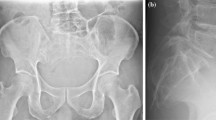Abstract
Sacral chordomas are rare, slow-growing tumours that are amenable to surgery, but unfortunately often diagnosed late. The aim of the study was to identify presenting symptoms, which may aid diagnosis and reduce the treatment time. Forty-four patients were identified with sacral chordoma between 1989 and 2006. Clinical and pathological records were reviewed retrospectively to elicit the symptoms recorded prior to diagnosis, duration of symptoms, surgical treatment, size of tumour and survival. Eleven patients were excluded, leaving 33 patients in the study group. Thirty-one patients had chordomas arising from the sacrum and two patients from the coccyx. The mean duration of symptoms prior to diagnosis was 120 weeks (2.3 years), with a median of length of 104 weeks (two years) and range of 26 to 416 weeks (0.5 to eight years). The mean maximum tumour size at resection was 8.3 cm, with a mean volume of 614 cm3 (range 9–2,113 cm3). Pain, typically dull and worse with sitting, was the most common presenting symptom in 85% of patients. The classic symptoms of cauda equina (saddle anaesthesia, bladder or bowel dysfunction) occurred in 70% patients (23 patients). Sacral chordoma should be considered in cases of back pain with coccydynia, especially with neurological symptoms.
Résumé
Les chordomes sacrés sont des tumeurs d’évolution lente. On peut être amené à les prendre en charges chirurgicalement avec un diagnostic souvent tardif. Le but de cette étude est de mettre en évidence les symptômes qui peuvent aider à un diagnostic plus précoce et réduire ainsi les délais du traitement. Quarante-quatre patients présentant un chordome sacré ont été analysés entre 1989 et 2006. Les signes cliniques et les éléments pathologiques ont été analysés de façon rétrospective sur le plan diagnostic, notamment durée des signes, ainsi que sur le plan du traitement chirurgical, taille de la tumeur et courbe de survie. Onze patients ont été exclus 33 patients restent dans le groupe d’étude. Trente-et-un patients avaient un chordome jouxtant le sacrum et 2 jouxtant le coccyx. La durée moyenne des signes avant le diagnostic était de 120 semaines (2 à 3 ans) avec une médiane de 104 semaines (2 ans) de 26 à 416 semaines (0.5 à 8 ans). La taille moyenne de la tumeur après résection était de 8.3 cm avec un volume moyen de 614 cm3 (9 à 2113 cm3). La douleur, typiquement assez sourde est aggravée par la position assise, il s’agit du signe le plus habituel chez 85% des patients. Le signe classique de syndrome de la « queue de cheval » survient chez 70% des patients (anesthésie en selle et dysfonction vésicale) (23 patients). Le chordome sacré doit être évoqué dans les cas de douleurs lombaires avec coccydynie spécialement s’il existe des signes neurologiques.



Similar content being viewed by others
References
Hoskin PJ, Neal AJ (2003) Clinical oncology 3rd edn, basic principles+practice: CNS tumours. Arnold, Hodder Headline Group, London, p 161
McMaster ML et al (2001) Chordoma: incidence and survival patterns in the United States, 1973–1995. Cancer Causes Control 12:1–11
Baratti D, Gronchi A, Pennacchioli E, Lozza L, Colecchia M, Fiore M, Santinami M (2003) Chordoma: natural history and results in 28 patients treated at a single institution. Ann Surg Oncol 10:291–296
Bissett D, Cassidy J, Spence RAJ (2004) Oxford handbook of oncology: bone and soft tissue malignancies. Oxford University Press, p 525
Anonymous (2000) Why a massive tumour went undetected. BMJ 320:523
Koes BW, van Tulder MW, Thomas S (2006) Diagnosis and treatment of low back pain. BMJ 332:1430–1434
Author information
Authors and Affiliations
Corresponding author
Rights and permissions
About this article
Cite this article
Jeys, L., Gibbins, R., Evans, G. et al. Sacral chordoma: a diagnosis not to be sat on?. International Orthopaedics (SICO 32, 269–272 (2008). https://doi.org/10.1007/s00264-006-0296-3
Received:
Revised:
Accepted:
Published:
Issue Date:
DOI: https://doi.org/10.1007/s00264-006-0296-3




